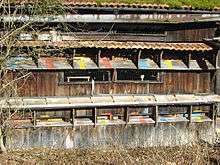Apiary
An apiary (also known as a bee yard) is a place where beehives of honey bees are kept. Traditionally beekeepers (also known as apiarists) paid land rent in honey for the use of small parcels. Some farmers will provide free apiary sites, because they need pollination, and farmers who need many hives often pay for them to be moved to the crops when they bloom. It can also be a wall-less, roofed structure, similar to a gazebo.
Etymology
Root Latin word apis – bee, from apiarius – of bees, apiarium – place of bees > beehouse, beehive. Compare with Latin avis – bird, aviarium > aviary.
Location

For pollination, apiaries are rarely set up; the bees are only present during the bloom period of the crop. But in a few cases, such as for organic farms, long term apiaries are established, with the rule of thumb being one hive per acre (4,046 m²) of the crop that needs pollination.
In the USA, there are beekeepers — from hobbyists to commercial — in every state. The most lucrative areas for American honey production are Florida, Texas, California, and the Upper Midwest. For paid pollination, the main areas are California, the Pacific Northwest, the Great Lakes States, and the Northeast. An apiary may have other hive management objectives including queen rearing and mating. In the northern hemisphere, east and south facing locations with full morning sun are preferred. In hot climates, shade is needed and may have to be artificially provided if trees are not present. Other factors include air and water drainage and accessibility by truck, distance from phobic people, and protection from vandalism.
Size
Depending on the nectar and pollen sources in a given area, the maximum number of hives that can be placed in one apiary can vary. If too many hives are placed into an apiary, the hives compete with each other for scarce resources. This can lead to lower honey and pollen yields, higher transmission of disease and robbing. The maximum size of a permanent apiary or bee yard may depend on the type of bee as well. Some honey bee species or races fly farther than others. A circle around an apiary with a three-mile (5 km) foraging radius covers 28 square miles (73 km2). A good rule of thumb is to have no more than 25–40 hives in a permanent apiary, although migrating beekeepers may temporarily place one hundred hives into a location with a good nectar flow.
External links
| Look up apiary in Wiktionary, the free dictionary. |
| Wikimedia Commons has media related to Apiary. |
- The River Wey and Wey Navigations Community Site – a non-commercial site of over 200,000 words all about the Wey Valley and includes a photo-essay about honey bees and apiary
- National Honey Board – June 2005 press release